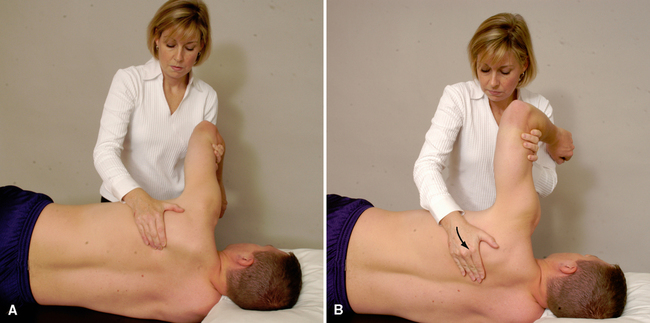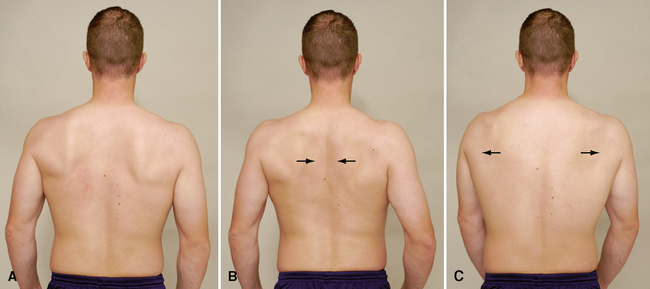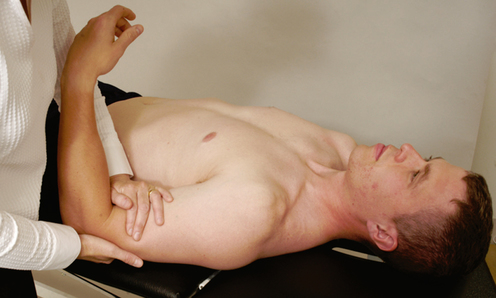CHAPTER 4 Précis of the Shoulder Assessment* Observation (sitting or standing) Active movements (sitting or standing) Elevation through forward flexion of the arm Elevation through scaption of the arm Elevation through abduction of the arm Horizontal adduction and abduction of the arm Scapular retraction/protraction Elevation through abduction of the arm Elevation through forward flexion of the arm Elevation through abduction at the glenohumeral joint only Horizontal adduction and abduction of the arm Special tests (sitting or standing) Muscle/tendon pathological conditions Empty can test (supraspinatus) Abdominal compression (Napoleon) test Medial rotation spring-back or lag test (subscapularis) Lateral rotation spring-back or lag test (infraspinatus/teres minor) Reflexes and cutaneous distribution (sitting) Resisted isometric movements (supine lying) Muscle/tendon pathological conditions Trapezius weakness—three positions (prone lying) Rhomboid weakness (prone lying) Pectoralis minor tightness (supine lying) Joint play movements (supine lying) Lateral distraction of the humerus Backward glide of the humerus in abduction Anteroposterior and cephalocaudal movements of the clavicle at the acromioclavicular joint Anteroposterior and cephalocaudal movements of the clavicle at the sternoclavicular joint *This assessment is shown in an order that limits the amount of movement the patient must do but ensures that all necessary structures are tested. After any examination, the patient should be warned that symptoms may be exacerbated as a result of the assessment. • Elevation in this position is sometimes called neutral elevation. • Patients with weakness spontaneously choose this plane when elevating the arm. • During elevation through scaption, scapulohumeral rhythm is similar to that of abduction, although there is greater individual variability. • Often, movement into elevation is less painful in this position than elevation through abduction, when the glenohumeral joint is actually in extension, or elevation in forward flexion. • Movement in the plane of the scapula puts less stress on the capsule and surrounding musculature and is the position in which most of the functions of daily activity are commonly performed. INDICATIONS OF A POSITIVE TEST When examining the movement of elevation through abduction, the examiner must take time to observe the scapulohumeral rhythm of the shoulder complex both anteriorly and posteriorly. During 180° of abduction, there is roughly a 2:1 ratio of movement of the humerus to the scapula, with 120° of movement occurring at the glenohumeral joint and 60° at the scapulothoracic joint. However, the examiner must keep in mind that a great deal of variability exists among individuals and may depend on the speed of movement; also, authors do not completely agree on the exact amounts of each movement.18–20 In the unstable shoulder, the scapulohumeral rhythm commonly is altered because of incorrect dynamic functioning of the scapular or humeral stabilizers or both. This may be related to incorrect arthrokinematics at the glenohumeral joint. Kibler21 pointed out that watching the movement of the scapula in both the ascending and descending phases of abduction is especially important. Commonly, weakness of the scapular control muscles is more evident during descent as many of the muscles are required to work eccentrically. An instability jog, hitch, or jump may occur when the patient loses control of the scapula. • In the first phase of 30° of elevation through abduction, the scapula is said to be “setting.” This means that the scapula moves minimally during this stage—rotating slightly in, rotating slightly out, or not moving at all. Therefore, there is no 2:1 ratio of movement during this phase. The angle between the scapular spine and the clavicle also may increase up to 5° at the sternoclavicular and acromioclavicular joints when elevating the arm; however, this depends on whether the scapula moves during this phase. • During the next 60° of upper extremity elevation (second phase), the scapula rotates about 20°, and the humerus elevates 40° with minimal protraction or elevation of the scapula. Therefore, there is a 2:1 ratio of scapulohumeral movement. During phase 2, the clavicle elevates because of the scapular rotation, but the clavicle still does not rotate or does so minimally. • During the final 90° of motion (third phase), the 2:1 ratio of scapulohumeral movement continues and the angle between the scapular spine and the clavicle increases an additional 10°. Therefore, the scapula continues to rotate and now begins to elevate. The amount of protraction continues to be minimal when the abduction movement is performed. During this stage, the clavicle rotates posteriorly 30° to 50° on a long axis and elevates up to a further 15°. Also during this final stage, the humerus laterally rotates 90° so that the greater tuberosity of the humerus avoids the acromion process. • During the second and third phases, rotation of the scapula (total, 60°) is possible because of the 20° of motion at the acromioclavicular joint and 40° at the sternoclavicular joint. • When the test is done in this fashion, the examiner must be aware that the range measured is not actually that of the glenohumeral joint alone. In fact, much of the range is gained by winging the scapula, or protraction of the scapula so when the patient does the movement, the examiner should watch for movement in the scapula. As soon as the scapula begins to move, it is usually the end of glenohumeral rotation. • With tight medial glenohumeral motion, greater winging and protraction of the scapula occur. • If the patient can abduct to 90°, it is often easier to measure medial rotation from this positon. • Measurement may also be taken by measuring the height of the patient’s radial styloid process as it reaches up the back. This eliminates variability in thumb position. • Care must be taken when applying overpressure with this movement, because it could lead to anterior subluxation/dislocation of the glenohumeral joint, especially in individuals with recurrent dislocation problems. • It is important to compare medial and lateral rotation, especially in active people who use their dominant arm at extremes of motion and under high load situations. The examiner should note any glenohumeral internal (medial) rotation deficit (GIRD), which is the difference in medial rotation between the patient’s two shoulders. Normally, the difference should be within 20°. This may also be compared with the glenohumeral external (lateral) rotation gain (GERG). If the GIRD/GERG ratio is greater than 1, the patient will often develop shoulder problems. Horizontal Adduction/Cross Flexion • To assess glenohumeral horizontal adduction instead of total shoulder horizontal adduction, the patient’s scapula can be stabilized into scapular retraction and the patient’s shoulder horizontally adducted. Alternatively, the clinician can assess when the scapula begins to move during the horizontal adduction motion. Movement of the scapula in either case indicates the end of glenohumeral motion and the beginning of scapulothoracic motion. Scapular Retraction and Protraction INDICATIONS OF A POSITIVE TEST Scapular retraction. Normally, the medial borders of the scapulae remain parallel to the spine but move toward the spine with the soft tissue bunching up between them. Ideally, the patient is able to do this movement without excessive contraction of the upper trapezius muscles. Scapular protraction. Normally, the scapulae move away from the midline; the inferior angle of the scapula commonly moves laterally more than the superior angle, resulting in some lateral rotation of the inferior angle. Commonly the two scapulae are tested simultaneously so that the examiner can visualize the difference between the two shoulders. A difference between the two sides indicates a positive test result. • If the serratus anterior muscle is weak or paralyzed, the scapula “wings” away from the thorax on its medial border. The serratus anterior also assists upward rotation of the scapula during abduction. Therefore, injury to the muscle (serratus anterior) or its nerve (long thoracic nerve) may limit abduction. • Similarly, weakness of the trapezius muscle, especially the lower part, can alter scapular mechanics, resulting in anterior secondary impingement. • The protraction/retraction cycle may cause a clicking or snapping near the inferior angle or supramedial corner, a condition sometimes called a “snapping scapula,” which is caused by the scapula rubbing over the underlying ribs. • Often the dominant shoulder shows greater restriction than the nondominant shoulder, even in the absence of a pathological condition. An exception would be individuals who continually use their arms at the extremes of motion (e.g., baseball pitchers). Because of the extra ROM developed over time doing the activity, the dominant arm may show greater ROM. However, the examiner must always be aware that shoulder movements include movements of the scapula and clavicle, as well as the glenohumeral joint. Many glenohumeral joint problems actually are scapular muscle control problems, which may secondarily lead to glenohumeral joint problems, especially in people under 40 years of age. • The scapular reach test (neck and back) is a similar test in which the patient does medial rotation and adduction (back reach) of both arms at the same time, then lateral rotation and adduction (neck reach) of both arms at the same time. By having the patient do the combined movements, the examiner gets some idea of the individual’s functional capacity and can easily see differences between the two sides. (See Figure 5-29 in Magee DJ: Orthopedic Physical Assessment, ed. 5.) • Passive movements may reveal the presence of a capsular pattern. The end feel of capsular tightness is different from the tissue stretch end feel or muscle tightness. Capsular tightness has a more hard and elastic feel to it, and it usually occurs earlier in the ROM. • If unsure of the end feel, the examiner can have the patient contract the muscles acting in the opposite direction 10% to 20% of the maximum voluntary contraction (MVC) and then relax. The examiner then attempts to move the limb farther into range. If the range increases, the problem was muscular, not capsular. POSTERIOR CAPSULAR TIGHTNESS TEST Flexion. The examiner places the palm of one hand on the anterior distal humerus to provide resistance near the elbow and uses the other hand to support the patient’s hand at the wrist. Extension. The examiner places the palm of one hand on the posterior distal humerus to provide resistance near the elbow and uses the other hand to support the patient’s hand at the wrist. Abduction. The examiner places the palm of one hand on the lateral distal humerus to provide resistance near the elbow and uses the other hand to support the patient’s hand at the wrist. Adduction. The examiner places the palm of one hand on the medial distal humerus to provide resistance near the elbow and uses the other hand to support the patient’s hand at the wrist. Medial rotation. The examiner places the palm of one hand on the distal forearm at the palmar aspect of the wrist to provide resistance, and the other hand just above the elbow. Lateral rotation. The examiner places the palm of one hand on the distal forearm at the posterior aspect of the wrist to provide resistance and the other hand just above the elbow. Elbow flexion. The examiner places the palm of one hand near the anterior wrist to provide resistance and uses the other hand to support the elbow. Elbow extension. The examiner places the palm of one hand near the posterior wrist to provide resistance and uses the other hand to support the elbow. • The disadvantage of testing shoulder isometrics with the patient in the supine position is that the examiner cannot observe the stabilization of the scapula during the testing. Normally, the scapula should not move during isometric testing. Scapular protraction, winging, or tilting during isometric testing indicates weakness of the scapular control muscles. • Although all the muscles around the shoulder can be tested with the patient in the supine lying position, some recommend testing the muscles in more than one position (e.g., different amounts of abduction or forward flexion) to determine the mechanical effect of the contraction in different situations. • If the patient history includes a complaint of pain in one or more positions, these positions also should be tested. If the initial position causes pain, other positions (e.g., position of injury, position of mechanical advantage) may be tried to further differentiate the specific contractile tissue that has been injured. • The relative percentages for isometric testing will be altered if tests are performed at faster speeds and in different planes. • If the patient history includes a complaint that concentric, eccentric, or econcentric (biceps and triceps) movements are painful or cause symptoms, these movements should be tested with loading or no loading as required. • When testing isometric elbow flexion, the examiner should watch for the possibility of a third-degree strain (rupture) of the long head of the biceps tendon (“Popeye muscle”).
SHOULDER
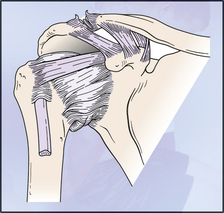
SELECTED MOVEMENTS
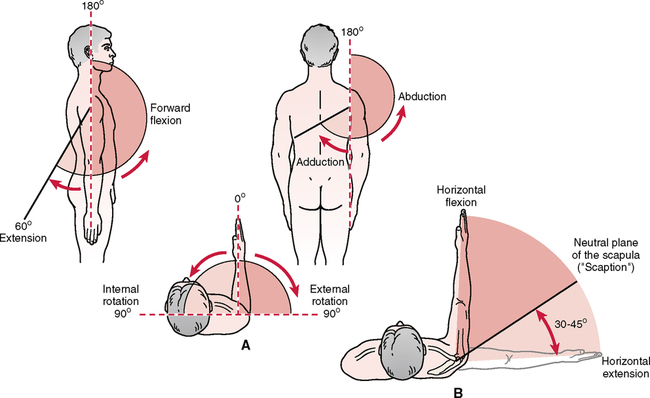
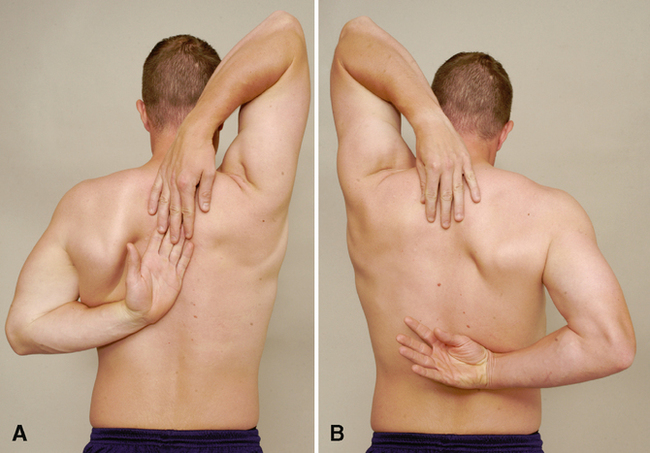
![]()
